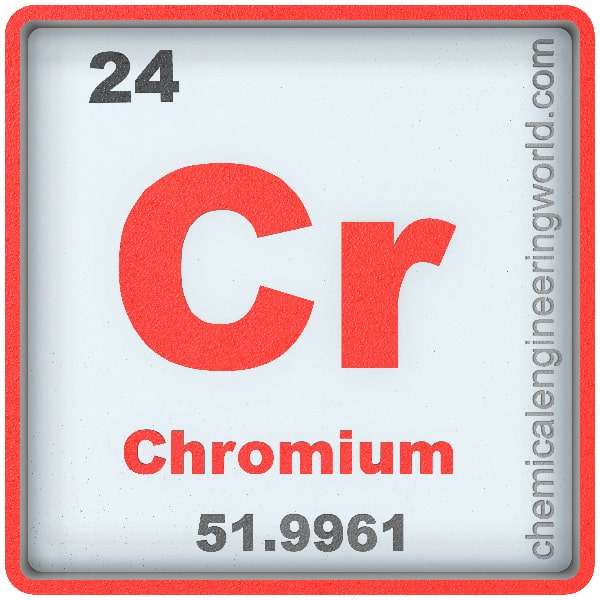Chromium Element Properties and Information

Chromium Element Properties and Information
Chromium is the twenty-fourth element on the periodic table. Elements are arranged in the periodic table on the basis of the atomic number. Atomic number is the number of protons in the nucleus of the atom. Chromium has an atomic number of 24. It is located in the Group 6 and Period 4 of the periodic table of elements. It is denoted by Cr. The name is derived from the Greek word ‘Chroma’ which means Colour.
Nicholas Louis Vauquelin is credited with the discovery of chromium. He was intrigued by a bright red mineral called crocoite which was analysed by him in 1798. He found that it was lead mineral. He isolated the lead and found that the liquor solution contained an unknown element, he named the unknown element as chromium because of the range of colours it was able to produce.
Chromium is the twentieth most abundant element on earth. It is found in combined with other elements. It is a widely distributed element in Earth’s crust. The main source of chromium on earth is a mineral called chromite.
Physical Properties
- Chromium is a steel-grey coloured, lustrous and hard transition metal.
- The atomic mass of chromium is 51.996
- The melting point of chromium is 1907°C
- The boiling point of chromium is 2672°C
- The density of chromium is 7190 in S.I. units at 20°C
- Chromium can be highly polished. Polished chromium reflects about 70% of the light in visible spectrum and 90% of infrared light.
- Chromium has three stable isotopes; chromium-52, chromium-53, and chromium-54. The chromium-52 is the most abundant comprising of 83.789% of the total chromium.
Chemical Properties
- Chromium is highly resistant to getting tarnished. It preserves it self from getting corroded however it does form a passivation layer on the surface when exposed to air.
- Chromium reacts with nitrogen at high temperatures to form chromium nitrides which are brittle in nature.
- Chromium(III) compounds tend to form octohedral complexes.
- Chromium(IV) compounds are oxidants at low of neutral pH.
- The chromium(VI) compounds formed by treating chromium trihalides with corresponding halogens are susceptible to disproportionate reactions and are not stable in water.
Methods of Production
Aluminothermic reaction: Chromite ore primarily contains iron and chromium. In order to obtain pure chromium, the iron is separated in a two step process; roasting and leaching. In the roasting step, the chromite ore is heated with a mixture of calcium carbonate and sodium carbonate in the presence of air. This causes iron to get converted to the stable form of iron oxide and the chromium to oxidise to its hexavalent form. The leaching is done at high temperatures, the iron oxide are insoluble and the sulfuric acid converts chromates to dichromates. The dichromates are then converted to chromium(III) oxide and then reduced by aluminium in an aluminothermic reaction.
Relevance in Chemical and Related Industries
- Metallurgy: Chromium is added to different metals in order to strongly increase corrosion resistance. It also has strengthening effect of forming stable metal carbides at the grain boundaries. Chromium coatings have above average durability when compared to other metal coatings.
- Pigments: Chrome yellow and chrome green are common pigments which are usually used for metal formulations and infrared reflecting paints.
Relevance in Other Industries
- Preservation: Chromium(VI) salts are toxic in nature hence they are used for the purpose of wood preservation. They protect wood from decaying due to fungi and they also protect the wood against the attacks of termites and other insects.
- Refractories: Adding chromite and chromium(III) oxide to refractory materials provides high heat resistivity and high melting point. A disadvantage is that the chromium may get converted to chromium(VI) which is toxic in nature.
Health Effects on Exposure
- Chromium(III): The chromium(III) is an essential nutrient required to human body but it should be present in the desired range which helps the body to function. Too much chromium(III) causes skin rashes and too less chromium(III) affects heart negatively and also results in diabetes.
- Chromium(VI): The chromium(VI) compounds can cause a variety of health problems based on whether they are ingested through breathing, drinking, eating or skin contact. Some of the health effects are skin rashes, ulcers, lung problems which can be cancer, damage to liver and kidney, alteration of genetic material and death.
Effects on Surroundings
- Plants: The chromium compounds can travel through air from exhausts of industries and accumulate in soil. Upon settling on soil they get attached due to which the chromium content of soil rises. Plants usually only absorb the chromium(III), but too much of it can have negative effects.
- Fish: Disposal of chromium metal products in the surface of water can damage the gills of fish who live near the point of disposal.
- Animal: The ingestion or inhalation of chromium causes respiratory problems in animals. It lowers the ability to fight disease by weakening the immune system. It can alter the cells resulting in tumor formations and birth defects.
References:
- https://en.m.wikipedia.org/wiki/Chromium
- https://www.lenntech.com/periodic/elements/cr.htm
- https://www.rsc.org/periodic-table/element/24/chromium
































